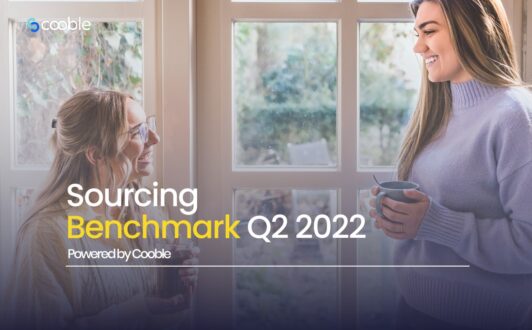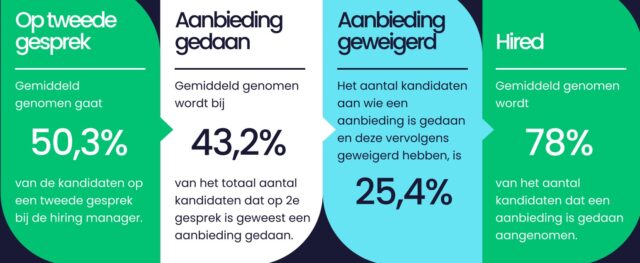
Never before have so many people been approached for a new job as in the past quarter. The so-called ‘ sourcing pressure ‘ rose to a record level of 37.9, or in other words: almost 4 in 10 workers receive an invitation or phone call from a recruiter at least once a quarter. What is the most effective approach? And how many hours does a recruiter need on average for sourcing to realize his hires ?
Nearly 4 in 10 workers receive an invitation or phone call from a recruiter at least once a quarter.
 Cooble , the Netherlands’ largest specialist in the field of sourcing, has been carefully mapping this since this year, via the so-called Sourcing Benchmark . The second edition shows, among other things, a significant increase in the number of sourced candidates who ultimately accept an offer. On average, more candidates also respond positively to an InMail.
Cooble , the Netherlands’ largest specialist in the field of sourcing, has been carefully mapping this since this year, via the so-called Sourcing Benchmark . The second edition shows, among other things, a significant increase in the number of sourced candidates who ultimately accept an offer. On average, more candidates also respond positively to an InMail.
May was positive
The month of May in particular was a positive outlier, according to Milou Verhoeks , partner and sourcing geek at the company from Den Bosch. “The best month of this year so far,” she even says. However, she does see that recruitment processes seem to take a little longer these days. But according to her, this may also have to do with the fact that people are becoming more mobile again, now that corona is largely behind them. ‘This means that more appointments will be physically scheduled again. That can make the time to hire take a little longer.’
‘You can clearly see that sourcing is now done for all industries.’
Another point that stands out in the second report is ’that sourcing is now done for all industries’, according to Cooble partner Jan Karel Sindorff . ‘Previously this was almost only for vacancies in IT and technology. But now you really notice that the need is great everywhere. We do see in our data that the response rate in technology is on average higher than in other sectors.’

Some other figures
Some other striking figures from the new benchmark:
- While in the first quarter a sourcer received an average response from 48.2% of the candidates he or she approached, this increased to 51.7% in the second quarter . “Candidates are more open to discussions, despite the fact that they are approached much more often than before,” Verhoeks concludes.
- However, the number of candidates with whom Cooble’s sourcers entered into discussions decreased (slightly). While in the first quarter a conversation followed in 7.5% of cases after an InMail, this has now decreased to 6.6% (roughly: from 1 in 13 to 1 in 15 candidates).
‘Candidates are more open to discussions, even though they are approached much more often than before.’
- On average, 43.2% of candidates who have attended a second interview actually receive an offer. In the first quarter of this year this was still 40.4% .
- In the second quarter, no less than 78% of candidates accepted an offer from a recruiter. A striking increase: in the first quarter this was just over 58% .
- The other side is also developing positively: fewer and fewer candidates are refusing an offer. While almost 31% of candidates refused an offer in the first quarter, this dropped to 25.4% a quarter later .

The entire benchmark?
Curious about the entire Sourcing Benchmark, including pro tips? Request it here .


